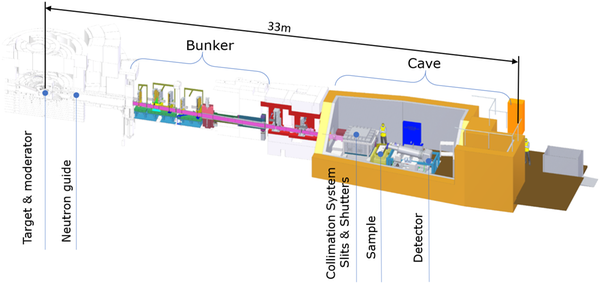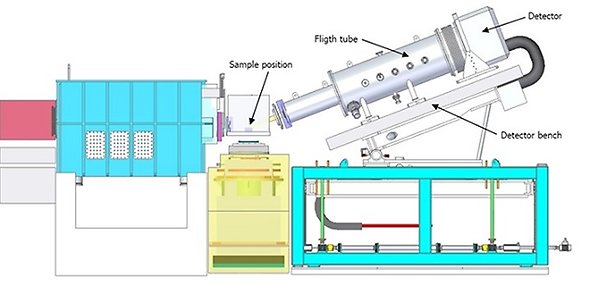Neutron Instruments at ESS
The FREIA Instrument at ESS
The Fast Reflectometer for Extended Interfacial Analysis (FREIA) to be installed in ESS is a horizontal reflectometer, which will provide unprecedented versatility with its 3 modes of operation: standard geometry, inverted geometry and unique capability of doing kinematic analysis. Its construction pioneers the use of elliptical guides and a fast shutter system, this way scientist will be able to do much faster measurements opening the realm of kinematic studies to the world.
The FREIA Laboratory is contributing to this world-leading instrument with the design of the detector bench and flight tube. These systems accurately position the detector in the path of the reflected neutrons and minimize the loss of them during the trajectory from the sample to the detector. The flight tube also allows the installation of a future polarization upgrade for further enhancing the capabilities of the instrument. The FREIA Laboratory, in close collaboration with ISIS Design Division (STFC) and partners at the ESS, is developing the mechanical design and dimensioning of these systems.
FREIA is a multi-purpose instrument with a horizontal sample geometry and a broad simultaneous momentum transfer (Q-range) for structural and kinetic studies. The instrument design has been optimised for the studies within condensed matter and life sciences. For maximizing the benefit of the high ESS flux for kinetic studies, a novel collimation system for measuring the full Q-range simultaneously has been designed. For example, it will be possible to study the kinetics of biochemical reactions in H2O like liquid-liquid interfaces e.g. oil-water.
Kinetic experiments on FREIA are done by selecting a part of the neutron beam from a beam with broad divergence, using two sets of precision slits and a system of fast beam shutters. The beam paths are thus constrained by three apertures and one, well defined-beam, can be formed by the collimation system on a per-pulse basis. The FREIA Laboratory is developing the fast shutter mechanism, operated in vacuum, which ensures that the aperture area is blocked and unblocked with a reaction time of 15 ms. Further work will be required to verify the neutron absorption performance and in optimizing the control system.


The SAGA Instrument at ESS
The European Spallation Source has identified a dedicated surface scattering beamline as a high priority for the next phase of instruments. Therefore, a wide consortium, building on the strength in surface and interface science in Sweden, has formed to push for a Swedish-led project to design and construct such a Grazing-Incidence Small-Angle Neutron Scattering (GISANS) instrument at ESS.
In this project, we develop a technical design for the world leading neutron surface scattering beamline including dimensions and components. The design of the instrument is directly motivated by the science and business case developed in coordination with the international community and will take full advantage of the brilliance of ESS. The output of the project will be a competitive instrument project proposal for the next ESS call and a detailed plan for the implementation of such a leading instrument. Particular emphasis will be dedicated to build competence in the development of neutron instrumentation in Sweden to enable strong engagement in the ESS instrument suite.
